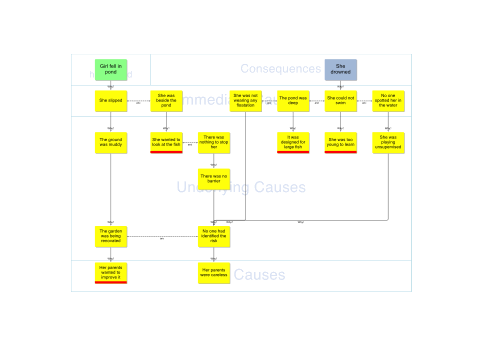Please be advised that the UK Office will be closed on Monday 8th May for the Coronation Bank Holiday and will re-open again at 9am on Tuesday 9th May.
Why Five?
We are sometimes asked how the Kelvin TOP-SET Root Cause Analysis (RCA) system compares with other RCA systems.
So, what about ‘5-Whys’? To make the comparison we first ask, “What does the phrase ‘5-Whys’ imply?” It implies that you have to take five ‘Why’ steps to get to a Root Cause. We don’t agree. It also implies that the steps are linear with no divergence or convergence. We don’t agree.
Let’s compare the two systems using an imagined but tragic incident, which happens all too often:
A 3-year-old girl falls into a garden pond and drowns. Can we undertake a 5-Why analysis on this? Yes.
Because she fell in the pond
Because she slipped
Becuase the ground was muddy
Becuase the garden was being renovated
Becuase her parents wanted to improve it
These five whys lead to a Root Cause, but the Root Cause, although true, isn’t very helpful.
Take a look at our analysis of the same incident below, and you get a totally different picture. The Root Cause is much more useful and informative, and many more related issues are addressed. The beauty of the Kelvin TOP-SET system is that there is no insistence on using five whys, and there is the freedom to diverge (branch out) or converge (come together) where necessary. Click image below for large view.
In truth, six criteria must have been met before this girl could drown: (1) She had to slip, (2) there must have been no barrier, (3) the water had to be deep enough for her to be submerged, (4) she must have been unable to swim, (5) she must not have been wearing a floatation device, and (6) she must have been unsupervised. She drowned because all six criteria were met. If you fixed any one of these, she would be alive and well.
The analysis shows that the Incident Statement is crisp and clear, and each part can be questioned easily.
Moreover, there can be as many Immediate Causes as you like, and as many ‘Why’ steps as you need. In this particular example there are six Immediate Causes, which is more than normal, and a maximum of four ‘Why’ steps, which is more than adequate to complete the analysis.
Therefore, a major problem with the 5-Whys is that it can easily result in much important information being omitted from the analysis. This is not good. The Kelvin TOP-SET analysis system is certainly SIMPLE but it is not SIMPLISTIC.
But, there is another serious flaw with the 5-Why approach.
We are not sure this is wise for two very significant reasons:
However, if we put a grid over the pond then we can be certain that same event will not happen again with their child, and better, any other child who happens to be playing in the garden! We have fixed an Immediate Cause and ensured that the same incident will never happen again. Was that worth doing? We think so.
So, the Kelvin TOP-SET approach is to analyse every event, thoroughly, using as many ‘whys’ as required, and looking at all the causes that contributed to the event: the Immediate Causes, the Underlying Causes and the Root Causes. Once complete, we then consider controls, barriers and defences at ALL levels of the analysis, not just the Root Causes.
Related News
TOP-SET Experiences
Derek Hibbard – Global Head of HSSEQ Compliance and Performance Improvement at Seadrill - speaks about his experience of the 3-Days Senior Investigator Course, the TOP-SET System and the value TOP-SET brings to his organisation.If you would also like to improve the...
Interviewing for Investigators
Kelvin TOP-SET's Managing Director David Ramsay speaks with Lead Tutor and Investigator Noel Kilpatrick about interviewing for investigators.Contact us below to find out more about interviewing in investigations and to discuss your specific requirements. We look...
Contact Info
Please don't hesitate to get in touch with any questions, to make a booking enquiry or to arrange for a presentation to learn more, and our team will get back to you shortly.




